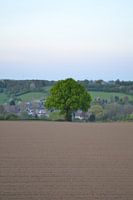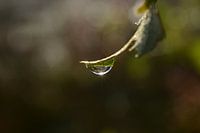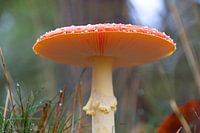Buy the photo European Currant Tree by tiny brok on canvas, ArtFrame, poster and wallpaper, printed on demand in high quality.
About "European Currant Tree"
by tiny brok
About the artwork
The European currant tree (Amelanchier ovalis) is a 1 to 4 m high shrub of the rose family (Rosaceae).
It is the only species of its genus that occurs naturally in Europe. The species also occurs naturally in the Caucasus and North Africa[1]. In Europe, the species is mainly found in mountainous areas. This species thrives on dry, warm growth sites on base-rich soil with little organic matter[2]. The thermophilic species becomes more common in France towards the south[3].
The underside of its green leaves is covered with fine hairs[2], an adaptation to dryness. The fine hairs give the underside of the leaves a grey-green to white appearance. The inflorescence consists of an upright, hairy, terminal raceme with three to nine white flowers. This species has the largest flowers of all currant trees. The fruits are blue-black berries with a crown on top. The fruit is juicy and sweet and therefore very popular with birds.
The European Union Currant Tree does not occur naturally in the Netherlands[1][4]. On the other hand, the American grapevine (Amelanchier lamarckii) does occur in the Netherlands[5]. This exotic species became established at the beginning of the 20th century and is found mainly in calcium-poor sandy soils[6]. In sharp contrast to the European currant tree, the American currant tree grows well in humid, slightly damp sites in partial shade. Such sites can be found, for example, in Drenthe. An obsolete name for the American Currant Tree is 'Drenthe Currant
About tiny brok
hobby fotograaf.. Read more…
 Netherlands
Netherlands Ordered in August 2017
Ordered in August 2017
 Germany
Germany Ordered in March 2023
Ordered in March 2023
 Netherlands
Netherlands Ordered in November 2019
Ordered in November 2019
 Netherlands
Netherlands Ordered in July 2022
Ordered in July 2022
 Germany
Germany Ordered in May 2025
Ordered in May 2025
 Germany
Germany Ordered in November 2020
Ordered in November 2020
 Netherlands
Netherlands Ordered in September 2023
Ordered in September 2023
 Netherlands
Netherlands Ordered in July 2018
Ordered in July 2018
 Netherlands
Netherlands Ordered in August 2019
Ordered in August 2019
 Netherlands
Netherlands Ordered in October 2017
Ordered in October 2017
 Germany
Germany Ordered in March 2019
Ordered in March 2019
 Netherlands
Netherlands Ordered in April 2020
Ordered in April 2020
About the material
ArtFrame™
Interchangeable Art Prints
- High-quality print
- Easily interchangeable
- Acoustic function
- Large sizes available
Discover the artworks of tiny brok
 dorpsstraatje in Viborg denemarken in de zomer van 2015tiny brok
dorpsstraatje in Viborg denemarken in de zomer van 2015tiny brok deze boom staat helemaal alleen in het limburgse landschaptiny brok
deze boom staat helemaal alleen in het limburgse landschaptiny brok night glow hotairballoonstiny brok
night glow hotairballoonstiny brok colorful tuliptiny brok
colorful tuliptiny brok hot air balloon during sunset in the polders of the Netherlandstiny brok
hot air balloon during sunset in the polders of the Netherlandstiny brok een druppel aan een takje in september in de vroege ochtend zontiny brok
een druppel aan een takje in september in de vroege ochtend zontiny brok Eindhoven Airport by nighttiny brok
Eindhoven Airport by nighttiny brok Fishing boat in harbour Lauwersmeertiny brok
Fishing boat in harbour Lauwersmeertiny brok Eindhoven city centre by nighttiny brok
Eindhoven city centre by nighttiny brok beautiful mushroom for a sweet gnometiny brok
beautiful mushroom for a sweet gnometiny brok walk through the watertiny brok
walk through the watertiny brok Hot air balloons in Inzelltiny brok
Hot air balloons in Inzelltiny brok stairwell in the lighthouse of Hvide Sandetiny brok
stairwell in the lighthouse of Hvide Sandetiny brok Porsche 911 Targatiny brok
Porsche 911 Targatiny brok Stairwell Design Museum Den Boschtiny brok
Stairwell Design Museum Den Boschtiny brok Stairwell Design Museum Den Boschtiny brok
Stairwell Design Museum Den Boschtiny brok Steel construction of the Maria Tower in haperttiny brok
Steel construction of the Maria Tower in haperttiny brok Crocustiny brok
Crocustiny brok peekabootiny brok
peekabootiny brok Walk with me into the unknowntiny brok
Walk with me into the unknowntiny brok













 Blossom
Blossom Photo wallpaper
Photo wallpaper Photography
Photography Serene Peace
Serene Peace Spring
Spring Vibrant Colors
Vibrant Colors









